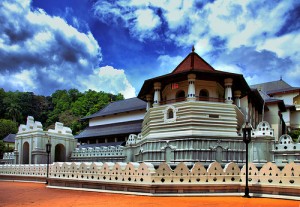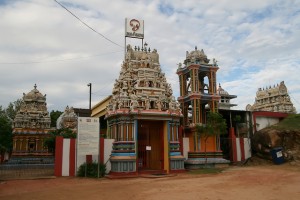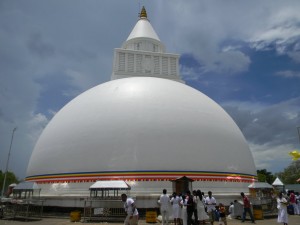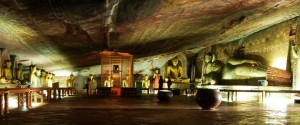Sri Lanka prides itself on having a great many temples. Like churches in Europe, they’re part and parcel of the communities all over the island, and where there is a village one is almost guaranteed to see saffron-robed monks sweeping the temple grounds at the crack of dawn.
There are, however, a few iconic temples that have shaped not just their communities, but the greater history and culture of the entire country. Exploring these are generally very cheap, but always wear clothes covering your legs and shoulder, and to remove your shoes.
The first is Kandy’s Sri Dalada Maligawa, the Temple of the Tooth. Legend has it that when Lord Buddha died, His body was cremated in a sandalwood pyre and his left canine tooth sent to the city of Dantapuri (in Odisha, or Orissa in India). It was said t hat whoever possessed the tooth possessed the divine right to rule the land, and so wars were fought solely to take possession of this relic. Eight hundred years later, facing an army of invaders hell-bent on destroying the tooth, a king sent his daughter and her husband with the tooth to Sri Lanka.
hat whoever possessed the tooth possessed the divine right to rule the land, and so wars were fought solely to take possession of this relic. Eight hundred years later, facing an army of invaders hell-bent on destroying the tooth, a king sent his daughter and her husband with the tooth to Sri Lanka.
In Sri Lanka, great palaces were built to house the tooth relic, and it was moved all over the land for safekeeping, until at last it was housed in the Sri Dalada Maligawa in Kandy. Here it has rested since then, in a sanctuary at the heart of the complex. It is never taken out, not even for the great Esela Perehera, an annual procession of song, dance and worship that brings all of Kandy to a halt; the Perehera itself must make do with the silver relic casket, accepted as a substitute for the relic itself.
The Temple complex itself has grown over the years, with numerous architectural and cultural additions – the golden canopy that marks the main shrine; the octagonal Pathirippuwa; the Alut Maligawa, a secondary shrine housing stunning Buddha statues representing a fantastic variety of styles of sculpture, with paintings that depict the story of the Buddhism in Sri Lanka.
Dambulla Temple
The Golden Temple, as is it called, is the largest and the most impressive cave temple complex in Sri Lanka, dating all the way from 100 BC. Outside, it is easily visible because of the massive golden Buddha statue that looks out over the entrance, facing the winding road. The statue fronts a vast rock that towers above the plain. Around this rock are over eighty documented caves, most of them natural grottoes that were excavated over the years.
The best exhibits lie in the five caves that lie under the rock. In the darkness, images on the cave walls and over 150 statues, hewn from the rock, point out landmark moments of the Buddha’s life. It is said that the cave temple began with King Valagambahu, who lived here for a decade and a half in exile before reclaiming Anuradhapura from South Indian invaders. In his gratitude, the king built the temple here, and over the centuries his successors added to it and restored what they could. Put together, the caves represent a work of worship over 20 centuries in the making.
Alu Vihararaya
The famous Alu Viharaya sits on the Dambulla-Matale road. The word “Alu” means “ash” in modern Sinhala, but once, it meant light. Here, the most important Buddhist scriptures in the word, the Tripitaka, were first committed to writing, after of existing purely in the minds and voices of monks. It is said that the same King Valagambahu who built the Dambulla Temple tasked 500 monks for this.
At its heart, the Alu Viharaya is a s eries of cave temples, linked by narrow stairs cut into the rock. The caves house a ten-metre long statue of a sleeping Buddha, and (respectively) sculptures of Buddhist hell, a cave temple to Valagambahu and the iconic Indian Buddhist scholar Buddhagosa and a bodhi tree apparently growing out of the rock. To the left is the International Buddhist Library and Museum, housing a copy of the Tripitaka as set down in ola leaves, in the tradition of what Sri Lankans call puskolapoth – apparently the same medium the Tripitaka was first written on.
eries of cave temples, linked by narrow stairs cut into the rock. The caves house a ten-metre long statue of a sleeping Buddha, and (respectively) sculptures of Buddhist hell, a cave temple to Valagambahu and the iconic Indian Buddhist scholar Buddhagosa and a bodhi tree apparently growing out of the rock. To the left is the International Buddhist Library and Museum, housing a copy of the Tripitaka as set down in ola leaves, in the tradition of what Sri Lankans call puskolapoth – apparently the same medium the Tripitaka was first written on.
Ambakka Temple
The Ambakka (or Embekke) Temple, in Kandy, is born from a strange legend, that of a drummer who, inflicted with an incurable skin disease, made the pilgrimage to Kataragama every year. At the last stages of his life, the god came to him in his dreams and instructed him to perform at a place where a miracle would happen. Soon, in a flower garden known as Ambakka, a tree began to bleed, and the drummer obeyed the god. Eventually he built a temple of branches around the tree, and the king of the region later ordered a huge temple built there and donated land and gifts to the temple.
The temple site itself is loosely divided into the inner and outer temples, and is built entirely of wood, without even the use of metal nails. Ambakka houses some of the greatest carvings in all of Sri Lanka, showcased on the pillars of the temple. These 126 carvings are all unique and are fantastic representations of Sinhalese art. Sadly, this site is nowhere near as cared-for as the older sites on this list.
Koneswaram Temple
Koneswaram, the Temple of a Thousand Pillars, is a sprawling Hindu temple complex in Trincomalee, built upon a promontory overlooking the Indian Ocean. A major place for Hindu worship, the geography of the region is of great symbolic importance. The original temple, existing roughly since 300 AD, was a shrine to the Hingu god Shiva. King Ravana, the mythical ruler of Sri Lanka in the 4th century epic the Ramayana, is believed to have worshipped Lord Shiva here.
Over the years, subsequent Hindu kings expanded Koneswaram, making the shrine part of three great temples that stood upon Swami Rock, as the promontory was called. The site was wrecked by the Portuguese in the 17th century, in what has since been called the biggest looting of the temples of Asia, and restored in the 20th century. There’s even a bit of Dutch history mixed in.
Koneswaram is a complex site, and home to many religious ceremonies and processions. Fantastic sculptures adorn the structures, carved in the classic Hindu tradition. It’s under renovation, which in itself is an interesting process to observe. Try to get there in the morning or in the evening, as the sun heats up the rock quite a bit.
Katharagama, situated in the far south of the island, is perhaps of the best examples of Sri Lanka’s fusion of cultures. Bordering the Yala National Park, Katharagama was once a capital of Sri Lankan kings, abandoned somewhere around the 13th century and resurrected as a multi-religious town primarily dedicated to god Katharagama.
The god’s exact origins are a mystery – some sources claim that it an indigenous deity, other than he is a king who came to be worshipped as a deity, and others that he is a Hindu god, and judging by historical records, a great cross-pollination of mythologies has occurred around this being. In any case, the site houses shrines, a mosque and a stupa. It is believed that the Buddha, on His third and last visit to Sri Lanka, discoursed to King Mahasena, who ruled the area in 580 BC. The Katharagama temple was built upon this site. Be aware that there is always a huge crowd of pilgrims at Kataragama, and that getting in might involve standing in line.


